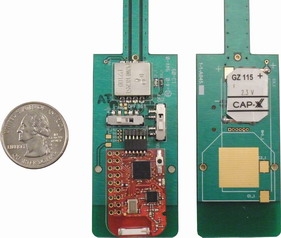Darnell nanoPower Forum - Today, engineers from Powercast and CAP-XX Limited (LSE:CPX) will introduce a wireless power module reference design combining Powercast's RF energy-harvesting technology with a CAP-XX supercapacitor to create a perpetual, battery-free power source for wireless sensors commonly used in environmental monitoring, building automation, industrial controls and other condition monitoring systems.
 Powercast RF Energy Harvesting Module This wireless power module combines Powercast's RF energy-harvesting technology with a CAP-XX supercapacitor to create a perpetual, battery-free power source for the wireless sensors commonly used in security, environmental and condition-monitoring systems. The module integrates a power receiving antenna, a Powercast Powerharvester to convert the radio waves into low DC power and a CAP-XX supercapacitor. The supercapacitor stores the harvested energy and provides peak transmission power to a wireless sensor/transmitter board such as the Texas Instruments eZ430-RF2500T. The complete module measures 8" tall x 1" wide x 4" thick.
Powercast RF Energy Harvesting Module This wireless power module combines Powercast's RF energy-harvesting technology with a CAP-XX supercapacitor to create a perpetual, battery-free power source for the wireless sensors commonly used in security, environmental and condition-monitoring systems. The module integrates a power receiving antenna, a Powercast Powerharvester to convert the radio waves into low DC power and a CAP-XX supercapacitor. The supercapacitor stores the harvested energy and provides peak transmission power to a wireless sensor/transmitter board such as the Texas Instruments eZ430-RF2500T. The complete module measures 8" tall x 1" wide x 4" thick.
Low-power energy harvesting can supply the average power required by many sensor-based systems, but cannot provide the peak power needed to collect and transmit data over wireless networks such as IEEE 802.15.4 (Zigbee), 802.11 (WLAN) or GSM/GPRS. This is the industry's first reference design using commercial components that harvests RF energy from low-power radio waves, stores it in a supercapacitor, and then delivers high power bursts when charged.
The wireless power module reference design integrates a power receiving antenna, a Powercast Powerharvester™ receiver, and a CAP-XX supercapacitor for energy storage and peak transmission power. Low-power wireless sensors or RF modules can be added with simple "two-wire" integration. The module measures approximately eight inches tall, one inch wide and ¼ inch thick at the body.
In operation, the design creates a perpetual power supply for fixed or mobile wireless sensor nodes, such as those located throughout a building, eliminating the need for batteries or wired power. Powercast's Powercaster™ transmitter, which powers this reference design, sends radio waves to the Powerharvester integrated into the module. The Powerharvester converts energy received from these radio waves into DC power, trickle-charges the supercapacitor, and then delivers power from the supercapacitor to the wireless sensor. This cycle repeats as the module receives additional radio waves, which can be sent continuously, on-demand or on a scheduled basis. This design uses the 915 MHz band, but can be adapted for other frequencies, or set to harvest environmental radio waves from TV, radio or mobile phone networks.
The Powercaster transmitter provides controllable, 24 x 7 wireless power, allowing wireless sensors to avoid using potentially unreliable ambient types of energy harvesting such as solar or heat.
CAP-XX vice president of applications engineering, Pierre Mars, and Powercast head of technology platforms, Charlie Greene, will present their collaborative paper, "Harvesting RF Energy and Powering a Wireless Sensor Node Using a Supercapacitor," in the energy harvesting session on Monday, May 18 at the Darnell nanoPower Forum in San Jose, California.
"This 'fit and forget' self-generating power source guarantees that sensors deployed throughout a building or local area will receive power without batteries or potentially unreliable environmentally-harvested energy such as solar or heat," said Mars.
"Wireless sensor networks are increasingly popular, but today are predominantly powered by disposable batteries," explained Harry Ostaffe, director of marketing for Powercast. "The RF energy harvester and supercapacitor combination eliminates the cost and hassle of replacing and disposing of batteries, and enables wireless sensor networks to scale to thousands of nodes with minimal maintenance."